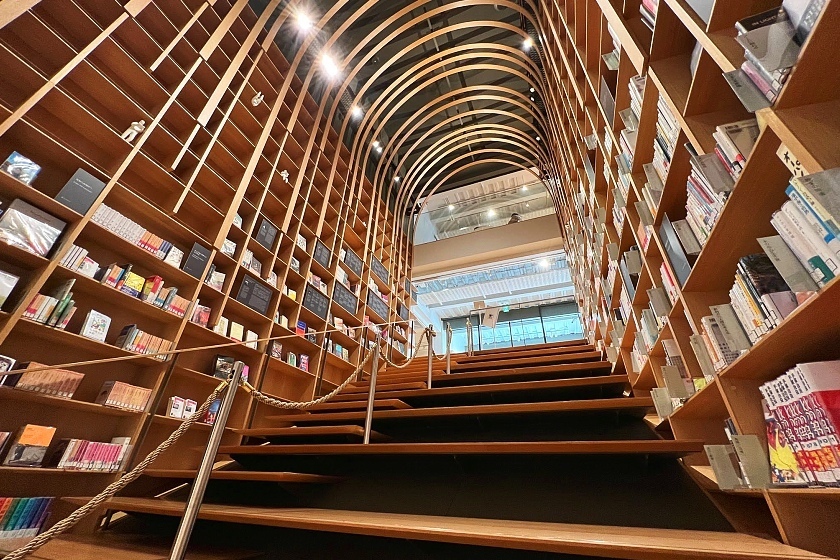A visit to the Murakami Haruki Library

Going back a few more years than I care to mention, I was a high-school student spending my weekends working at a local bookstore when I first got my hands on a Murakami. It was The Wind Up Bird Chronicle - a fascinating, dreamlike story beginning with an unemployed suburban man's search for a missing cat.
Over the years, I found myself returning again and again to his work, known for its surreal elements, themes such as love, alienation and the search for identity, and for its suffusion of western culture and music. At 74, Murakami remains a prolific author and translator of western novels into Japanese, and with the runaway success of the 2021 film Drive My Car - based on one of his short stories - has found himself once more in the public eye.
In the course of a career spanning almost half a century, the author amassed a vast collection of materials from unpublished manuscripts to his own library of books. Realizing that the collection had grown far beyond what he could manage, Murakami made the decision to donate it to Tokyo's Waseda University, from where he had graduated as a student of drama back in the seventies.
Charged with renovating one of the universityfs existing buildings to house the collection, the architecture studio Kuma Kengo and associates (KKAA) - now a household name for high profile works like the National Stadium in Shinjuku - have channeled the spirit of the author's work by transforming an ordinary, utilitarian space into something sleek, stylish and fun to explore. Known officially as the Waseda University International House of Literature, the building opened to the public in October of 2021.


From outside, the library seems like any other in its functional, campus-style surroundings. With a second glance, we see that the exterior has been completely painted over in white, giving it the feel of a blank canvas while preserving its original, boxy form. The first clue that something different is going on is an undulating canopy of steel and wooden slats, wrapping around the side of the building to form an archway over the main entrance.
Once inside, visitors are immediately faced with the building's centerpiece - a large open atrium that is also a staircase leading down to the basement level, with strikingly tall bookcases reaching up to the ceiling on either side, meeting in gracefully curved slats at the very top. Commenting on the design, KKAA described the space as like a tunnel between dimensions, while the curving lines reflect the gkindnessh of Murakamifs work.


Turning right at the top of the eye-catching staircase, the next thing we see is a stylish listening room, commemorating the 20,000 vinyl records included in the author's archive. With sleek, mid-century furniture and jazz playing softly through high-end speakers, the room feels almost like slipping into one of the classic books.


On the opposite side is a quiet reading room, with shelves of books loosely organized by topic and a long work table for visitors to sit and enjoy them. In a nod to Murakami's first job as the owner of a Tokyo jazz club, the room also includes some antique chairs kept from the now-defunct venue.


The basement level is home to a student-run cafe called Orange Cat, where we find more bookcases, a baby grand also from Murakami's old jazz club and a mock-up of the author's home writing room, although this is behind glass and usually inaccessible to visitors.


Up on the second floor, visitors can peruse a large collection of novels, anthologies and magazine clippings, creating an interesting overview of Murakami's own work and his contemporaries. The many foreign articles and translated copies serve to highlight the authorfs greater popularity beyond Japan's shores.
Over on the opposite site is an open and simply furnished event space, intended to serve as an occasional venue for lectures or even musical performances.


Perhaps the best part of the third floor is a little seating area with a commanding view into the main atrium - one of several peaceful spots throughout the building perfect for a quiet chat or to hide away with a book.


As a big fan of both Murakami and KKAA, I was delighted to see the creative interplay between these two giants of modern Japanese culture. Despite being just a little off the beaten track of Tokyo's better known tourist spots, I expect the beautifully designed atrium to become a common sight on instagram feeds, and would highly recommend a visit to anyone with an interest in architecture or the author himself.

Admission
The library is free to enter, but visitors are strongly encouraged to reserve a time slot in advance via the university's website. Time slots last 90 minutes and are available at 10:10-11:40, 11:55-13:25, 13:40-15:10 and 15:25-16:55. The library is closed on Wednesdays and at other irregular times, so please check the library calendar.
Access
From Otemachi Station, located just five minutes on foot from Tokyo Station, take the Tozai Line to Waseda Station (10 minutes, 170 yen). From Waseda Station, it's a ten minute walk through the university campus to the Waseda International House of Literature.





